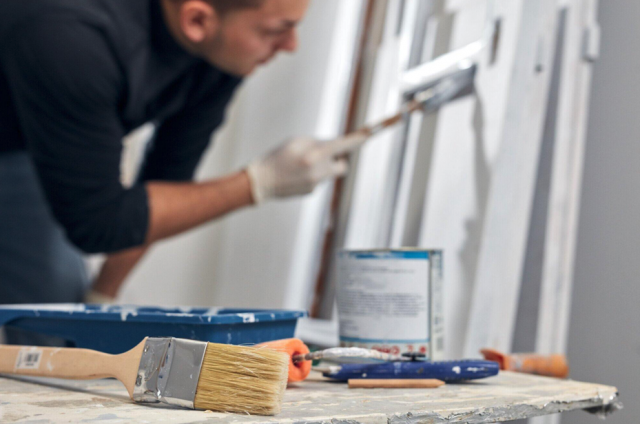The art of painting an apartment is akin to the role of a conductor in an orchestra. The colors you choose are the notes that decide the harmony and mood of your living space.
Painting is one of the most transformative DIY projects, whether moving into a new place or spicing up your current abode. It all starts with selecting the right color palette for an apartment painting project.
In our deep dive, we will explore the intricacies of color theory, share some popular color schemes, and provide a comprehensive guide to help you bring your vision to life.
Read on to learn more.
The Significance of Color in Your Space
Color isn’t just an aesthetic choice; it profoundly impacts your mental and emotional state. The colors you select for your apartment can make a cramped room feel more expansive or coax a lively area into a soothing sanctuary at the end of a long day. Understanding color is key to harnessing its power and ensuring that power serves your living space nicely.
Understanding Color Theory
Before you can embark on your commercial painting project, you must grasp the basics of color theory. It’s the framework upon which you’ll build your apartment’s palette.
The Basics
The color wheel is your starting point. Divided into twelve segments, the wheel encompasses three categories: primary, secondary, and tertiary colors. Primary colors are the building blocks; combining them creates secondary colors, and further mixing brings you to tertiary shades.
Warm vs. Cool Colors
Warm and cool colors have fundamentally different effects. Warm hues, like red and yellow, are invigorating and exude energy, making them ideal for social spaces. Cool tones, such as blue and green, are calming and promote relaxation, suitable for bedrooms or meditation nooks.
Considerations for Apartment Painting Projects
When painting an apartment, select colors with the apartment’s unique features in mind. Natural and artificial lighting, room size, and existing furniture all inform your color decisions.
Lighting Conditions
Lighting can dramatically alter the appearance of paint colors. Rooms with ample natural light can handle dark and light hues, while those with less light may benefit from lighter shades to avoid a boxy, oppressive feel.
Room Size and Purpose
The size and function of each room should dictate your color choices. In a small room, lighter colors can make it feel more open, while a cozy library or den might call for rich, inviting colors that encourage relaxation.
Existing Décor
Incorporating your apartment’s existing elements into your color scheme ensures a cohesive look. Your favorite green couch or wooden floors dictate complementary paint colors that enhance rather than clash.
Research Popular Color Schemes
Color schemes work well together and are the foundation for apartment designs. Let’s explore four of the most common schemas.
Monochromatic
A monochromatic scheme uses different shades of the same hue. This approach creates a sense of harmony and calmness within a space.
Complementary
Complementary colors are opposite on the color wheel. When used together, they deliver high contrast and a vibrant aesthetic.
Analogous
Analogous colors sit adjacent to the color wheel and provide a cohesive. It has a comfortable feel and brings a sense of unity to a space.
Triadic
It uses three colors equally spaced around the color wheel. A triadic scheme offers a balance of vividness and coordination between the three hues.
Tips for Choosing the Perfect Color Palette
Here are some practical tips to guide you through selecting the perfect color palette for your apartment.
Sample Paint Colors
Never underestimate the power of a paint swatch. Sample pots of potential paints let you see how the color looks in your space under your lighting conditions before you commit.
Consider Mood and Atmosphere
A living room for lively gatherings demands different colors than a solitary workspace dedicated to focus and productivity. Think about the mood you want to evoke.
Painting Techniques to Alter Perception
Simple painting techniques like an accent wall or horizontal stripes can alter the perception of room size and have a significant visual impact on the space.
The Role of Finish in Your Color Selection
While the color is fundamental, the paint’s finish or sheen can profoundly affect the walls’ final appearance and maintenance. The finish dictates the paint’s durability and reflectivity from matte to high-gloss.
Matte Finish
Matte paint provides a non-reflective surface, ideal for hiding minor wall imperfections. Its subtle look creates a soft ambiance but is best for low-traffic areas due to its lower resistance to marks and scuffs.
Eggshell Finish
Slightly more lustrous than matte, the eggshell finish has good washability and a bit more durability, making it a suitable compromise for living spaces.
Satin Finish
Satin offers a pearl-like sheen and is more resilient to cleaning, which is excellent for higher-traffic areas like hallways and children’s rooms.
Semi-Gloss and Gloss Finish
For areas that contend with moisture and wear, such as kitchens and bathrooms, semi-gloss and gloss finishes are ideal, providing high durability and ease of cleaning.
Integrating Paint Effects
Beyond solid colors, various painting techniques can add texture and depth to your walls or even change how the room’s size is perceived.
Textured Paint
Textured paint can give your walls a unique feel, from a sandy beach vibe to an antique plaster effect. It’s a creative way to add character to a room.
Color Washing
For a softer, more dynamic look, color washing layers a glaze over a base coat of paint, offering a beautiful depth and richness.
Stenciling
Stencils allow you to apply patterns, shapes, and designs, adding a personal touch ranging from intricate Moroccan motifs to simple geometric shapes.
If you are looking for the best commercial painting company, look at Fresh Coat Painters of East Reading. This is where they provide superior workmanship and an exceptional customer experience.
Make the Most Out of Your Apartment Painting Project
Selecting a color palette for your apartment painting project is an exciting adventure into the design world. Remember, the perfect color palette should harmonize with the energy and purpose of each room and with your style. So, deeply dive into color theory, understand your space and existing décor, and use popular color schemes as guidelines, not rules.
With these insights, you’re well on your way to transforming your apartment into a canvas of personal expression. Happy painting!
For more helpful tips, check out the rest of our site today!






